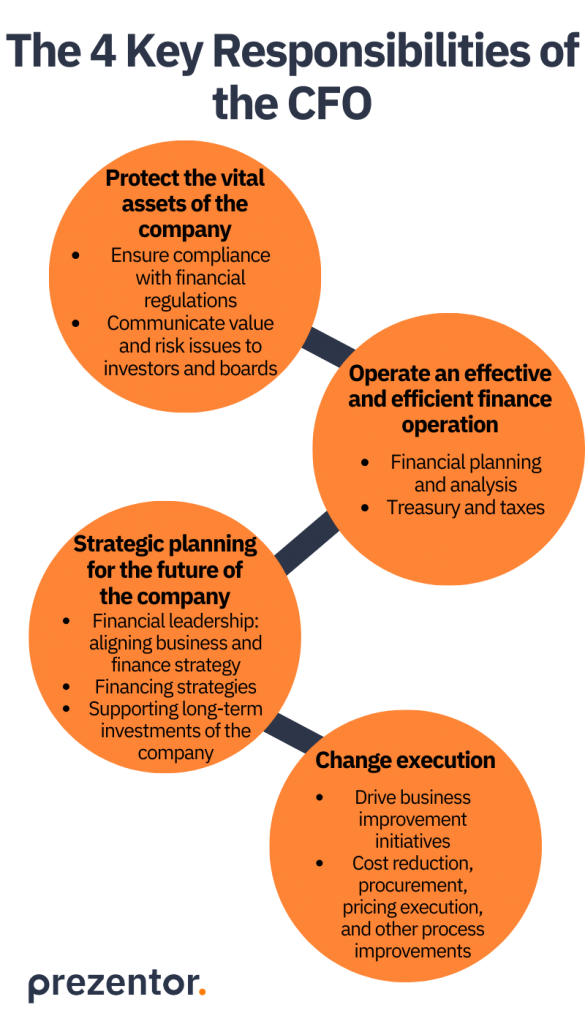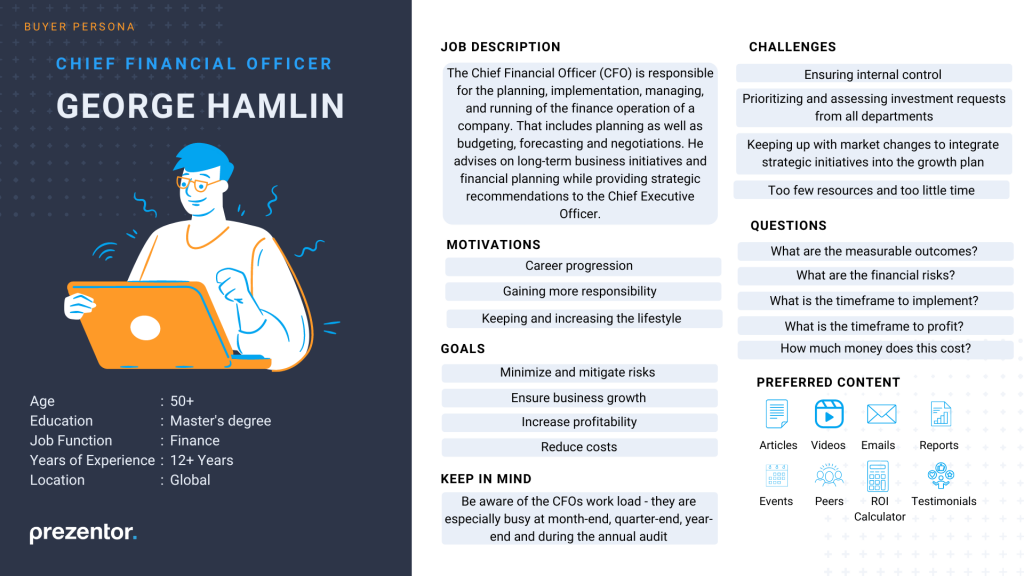How to Sell to the CFO
2023 is set to be a tough year for sellers as companies are looking to cut their investments on products and solutions across the organization. While companies are evaluating what solutions are mission-critical, the buying committee is growing, and new stakeholders are involved in making purchase decisions. This means that sellers need to adjust their current sales techniques to cater to new stakeholders and buyer personas.
In this blog post we will cover the main areas sellers need to understand to sell effectively to the Chief Financial Officer in 2023:
- Why is it important to sell to the CFO?
- Understanding the CFO and creating a buyer persona
- How to sell to the CFO effectively
Why is it important to sell to the CFO?
Experienced sellers know that the finance department is always involved in the buying process and are used to catering to stakeholders assessing the legal and financial requirements. The involvement of the finance department in the buying process has increased, and they now hold a bigger responsibility. Especially the Chief Finance Officer will be a key persona in 2023 that can make or break deals. Being tasked with running an efficient and effective finance operation, the CFO is a key player in the decision-making process to assess the strategic purchasing of products and services.
Therefore, sellers must understand the key responsibilities of the Chief Finance Officer, what goals the persona has, and find effective ways to communicate with the CFO to win their approval.
Understanding the Chief Financial Officer and creating a buyer persona
Understanding the key responsibilities of the Chief Financial Officer and creating a buyer persona is an effective way for sellers to understand what the key concerns of CFOs are, and how they can address them. In this paragraph we will guide you through the CFO’s key tasks in 2023 and their goals. This information will help you to create a buyer persona and understand the CFO’s role in the buying committee.
The 4 Key Responsibilities of the CFO
The Goals of the Chief Financial Officer
In the current economic climate CFOs are under the pressure to cut costs, grow revenue, and ensure control all the while ensuring an efficient and effective finance operation. While investments are necessary to drive growth, the CFO needs to ensure that spending is not becoming unpredictable and need to understand spending in relation to revenue growth.
The main goals of the CFO:
- Minimize risks: There are plenty of financial risks in today’s world, but some of the risks CFOs are concerned about are the lack of internal control, cybersecurity threats, and unpredictable rises in cost. To minimize risks the CFO identifies the risks, assesses them, manages them, and integrates them into the company strategy
- Ensure profitable growth: The CFO analyzes the relation between spending and growth and assesses the profitability of the investments and current operating costs. Based on this the CFO develops business improvements such as improved cost reductions, procurement, and pricing execution.
The Chief Financial Officer Buyer Persona
The CFO's Role in the Buying Committee
The role of the CFO in the buying committee is of course dependent on the product or solution you are selling, but no matter what department will have the most benefits from your product – the CFO will be a part in the buying committee.
Most likely, the CFO is not the main driver of the buying process but will become part of the buying committee once the buyer has assessed your solution and is evaluating the costs and implementations. This means the CFO won’t be part of demos or product tests, and most likely won’t see your product first hand.
While the CFO will first be part of the buying committee at a later stage of the buying process, they must give their approval for the purchase, and are a key decision-maker.
The CFO assesses the following aspects in the buying committee:
- What are the measurable outcomes of your product?
- What are the financial risks of your product?
- What is the timeframe to implement, to results, and to profit?
Sellers must ensure to address these questions to sell effectively to the CFO and to get their approval.
Information Sales reps need to gather to approach the CFO
Creating a buyer persona for the CFO and understanding their general role is helpful, but sellers are faced with different companies that have various company goals and therefore also different ways of working. There is a variety of information sellers need to gather to fully understand the priorities of their buyer to tailor the communication and sales process to the buying committee.
Sellers need to gather the following information to understand the CFO’s needs:
- What are the biggest risks the company currently faces?
- What are the company goals?
- What are the company’s financial needs?
- What are the financial due diligence requirements?
- What solutions has the company purchased previously?
Most of these questions your buyer will be able to answer, giving you the possibility to create a bulletproof plan for your presentations and interactions based on the solutions to the company’s problems.
How to sell to the CFO effectively
Now that we have covered what the key concerns of the Chief Finance Office are, what they are tasked with, and what role they play in the buying process, it’s time to look at effective ways of communicating with the CFO and the types of content CFOs care about.
Top Tips from Industry Experts
We gathered the top tips on how to sell to the CFO in 2023 from industry experts which can help sellers to identify the CFO’s needs and cater to them specifically. The insights gathered here should be used to inform the communication with CFOs to sell effectively.
How to communicate with the Chief Financial Officer
Yes, CFOs are also just people, but most likely they pursued a career in Finance because they are analytical, skeptical, and prefer numbers over words. Sellers must take this into account to communicate with CFOs effectively as you surely don’t want to end up annoying or boring one of the most important decision-makers of the buying committee.
As CFOs prefer numbers and don’t have time to waste, your communication must be concise and clear, rather say fewer words than too many. Additionally, you should focus on value and consider what value the CFO gets from the interaction with you. If the value is 0 your deal will likely end as a closed lost.
CFOs are realists; sellers should be realistic as well when communicating with CFOs. Be clear and transparent about the risks involved as the CFO will calculate these risks anyway. By addressing them directly, sellers can show that they are experts and understand the buyer’s concerns. This gives sellers a unique possibility to create a valuable dialogue and help in giving solutions on how to mitigate the risks.
The CFO determines the buying decision based on how likely your solution is to improve business growth, profitability and help reduce costs. Here you find an overview of four key points to communicate to the CFO.
4 Points Sales reps must communicate the CFO
- Show the size of the problem and make your solution relevant:
- How much revenue is the company currently losing?
- How many people/ teams in the company are affected by this?
- How much money does your solution cost?
- Establish financial metrics to speak the language of the CFO
- Create value by sharing the ROI of your solution. To increase credibility, include information on how the ROI was calculated and the source of the numbers.
- Show the impact of your solution on the buyer’s profitability with the NPV (Net Present Value). The Net Present Value analyses the profitability of the investment over the entire life of the investment. Providing this metric can be powerful in closing a deal for a longer time period.
- Share a business case for your solution
- Your buyer will have to provide a business case for the CFO. Take the pain of the buyer away and create a business case yourself that can be shared in the buying committee for transparency.
- All information used for a business case needs to be credible to build trust and show that you are an expert that understands the buyer and their problems very well.
- Show how your solution aligns with company goals
- The CFOs main goal is to achieve the company goals and all business decisions need to support these goals. Therefore, sellers must show that their solution can help the buyer achieve that goal.
- Focus on 2 to 3 goals and give specific inputs on how your solution can help achieve them. Customer statements can be very effective in communicating the value of your solution while also adding credibility by referencing a 3rd party.
Content the Chief Financial Officer wants to read
CFOs spend their everyday with vetting information, assessing scenarios, and analyzing data. They are trained to be skeptical and second-guess what they are provided with. Therefore, sellers must be prepared that the CFO will investigate any numbers and content they share, and they will find out if things don’t add up.
Sellers should share insightful content with the CFO to ease that process and make it simple and efficient. Providing helpful content also allows the seller to provide a great source of credible information that showcases your solution. Here are the main types of content CFOs use when validating solutions.
- Customer testimonials from CFOs
CFOs trust their peers, because they know they speak the same language, share the same pains, and have the same goals. This is an opportunity for sellers to share customer testimonials of existing customers and provide statements from their CFOs. As the customer decided to purchase your solution, their CFO can share answers as to why they purchased their decision, what factors they considered, and what impact they have seen so far.
2. ROI Calculators
It shouldn’t be any surprise that an ROI calculator is the kind of content the CFO likes and understands. Depending on what tools you have available it’s not difficult to create ROI calculators that sellers can use in their interactions with buyers.
Ideally, the ROI calculator sellers use is branded, easily sharable, and dynamic allowing the CFO to adjust the value inputs and calculate various scenarios. Prezentor offers ROI calculators that are dynamic, easy to create and share, and trackable, allowing sellers to see exactly how buyers engage with them. Here you can learn more about how our value calculators work.
3. Analyst Reports
CFOs understand how analysts operate and know that the reports created by analyst firms are credible and valid. Reports from Gartner, Forrester or IDC to name a few can be effective when communicating to the CFO as they give a high-level overview of your solution and product category. As analyst reports often name several solutions, they can be very beneficial for CFOs as they give a good overview of the competitive landscape, allowing the CFO to assess the risks and benefits involved.
4. 3rd party Benchmarks & Research
When it comes to research and market benchmarks for the CFO the more is the merrier. Sharing research from credible third-party sites is valuable content for CFOs that can help them to validate your solution.
In 2023 sellers won’t be able to get around the CFO in the buying process. Even if the CFO won’t be present in buyer interactions, the Chief Finance Officer is a decision-maker and one of the most important key stakeholders of any strategic purchase decision. Therefore, sellers must provide effective content to ease the buying process for the buyer as the buyer has the market power and enough solutions and products to choose from.
To sell effectively to the CFO sellers must:
- Prove that your solution is mission-critical by relying on 3rd party data and testimonials
- Make clear that your solution drives return through ROI calculators
- Communicate value by aligning your solution to company goals



